
Two major eclipses of the Moon and a partial eclipse of the Sun over eastern North America highlight the astronomical year of 2021.
I provide my selection of three dozen of the best sky sights for 2021. I focus on events you can actually see, and from North America. I also emphasize events with the potential for good “photo ops.”
What I Don’t Include
Thus, I’m excluding minor meteor showers and ones that peak at Full Moon, and events that happen with the objects too close to the Sun.
I also don’t include events seen only from the eastern hemisphere, such as the April 17 occultation of Mars by the Moon — it isn’t even a close conjunction for us in North America. The August 15 rare triple transit of three Galilean moons at once on the disk of Jupiter occurs during daylight hours for western North America, rendering it very challenging to see. An outburst on August 31 of the normally quiet Aurigid meteor shower is predicted to happen over Asia, not North America.
I also don’t list the growing profusion of special or “supermoons” that get click-bait PR every year, choosing instead to limit my list to just the Harvest Moon of September as a notably photogenic Moon.
Good Year for Lunar Eclipses
But two Full Moons — in May and in November — do undergo eclipses that will be wonderful sights for the eye and camera. As a bonus, the Full Moon of May is the closest Full Moon of 2021, making it, yes, a “supermoon.”
The New Moon eclipses the Sun on June 10, bringing an annular eclipse to remote regions of northern Canada and the Arctic (including the North Pole!). Eastern North America and all of Europe can witness a partial solar eclipse this day.
Recommended Guides

For an authoritative annual guide to the sky and detailed reference work, see the Observer’s Handbook published each year in Canadian and U.S. editions by The Royal Astronomical Society of Canada. I used it to compile this list.

The RASC has also partnered with Firefly Books to publish a more popular-level guide to the coming year’s sky for North America, in the 2021 Night Sky Almanac, authored by Canadian science writer Nicole Mortillaro. It provides excellent monthly star charts.
However, feel free to print out my blog or save it as a PDF for your personal reference. To share my listing with others, please send them the link to this blog page. Thanks!
January
The year begins with a chance to see three planets together at dusk.
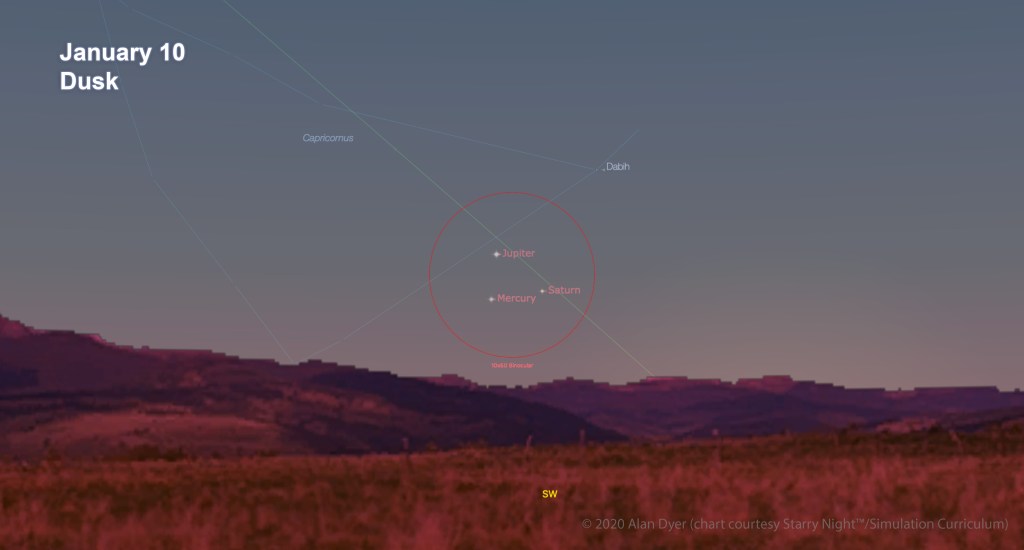
January 10 — Mercury, Jupiter and Saturn within 2 degrees (°)
Even three weeks after their much publicized Great Conjunction, Jupiter and Saturn are still close and visible low in the evening twilight. On January 10 Mercury joins them to form a neat triangle of worlds, but very low in the southwest. Clear skies and binoculars are a must!
NOTE: The red circle on this and most charts represents the 6.5° field of view of a typical 10×50 binocular. So you can see here how binoculars will frame the trio perfectly. All charts are courtesy the desktop app Starry Night™ by Simulation Curriculum.

January 14 — Thin waxing crescent Moon above line of Mercury, Jupiter and Saturn
Saturn disappears behind the Sun on January 23, followed by Jupiter on January 28, so early January is our last chance to see the evening trio of planets, tonight with the crescent Moon.

January 20 — Mars and Uranus 1.6° apart
Uranus will be easy to spot in binoculars as a magnitude 5.8 green star below red Mars, so this is your chance to find the seventh planet. The quarter Moon shines below the planet pair.
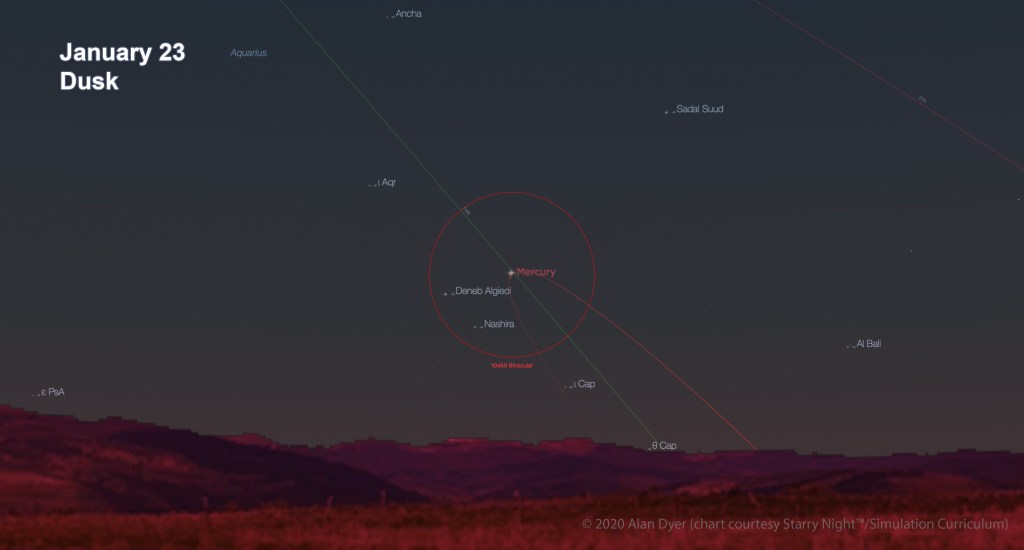
January 23 — Mercury at a favourable evening elongation
This and its appearance in May are the best opportunities for northern hemisphere observers to catch the innermost planet in the evening sky in 2021. Look for a bright magnitude -0.8 “star” in the dusk twilight.
February
This is a quiet month with Mars the main evening planet, but now quite small in the telescope.

February 18 — Waxing Moon 4° below Mars
The pairing appears near the Pleiades and Hyades star clusters high in the evening sky.
March
Mars shines high in evening sky in Taurus, while the three planets that were in the evening sky in January begin to emerge into the dawn sky.
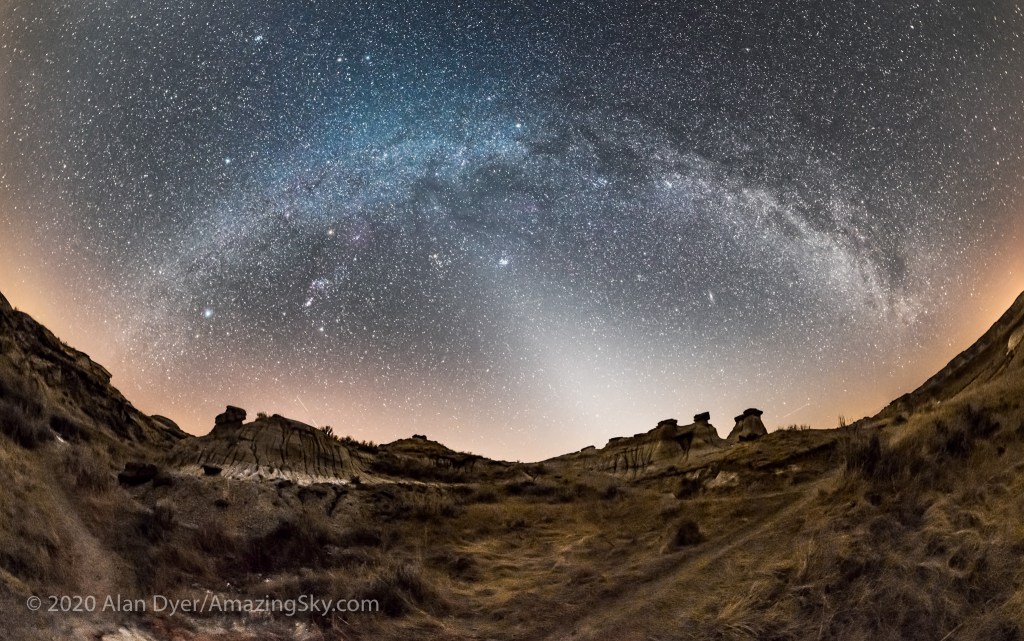
March 1 — Zodiacal light “season” begins in the evening
From sites away from light pollution look for a faint glow of light rising out of the southwest sky on any clear evening for the next two weeks with no Moon.
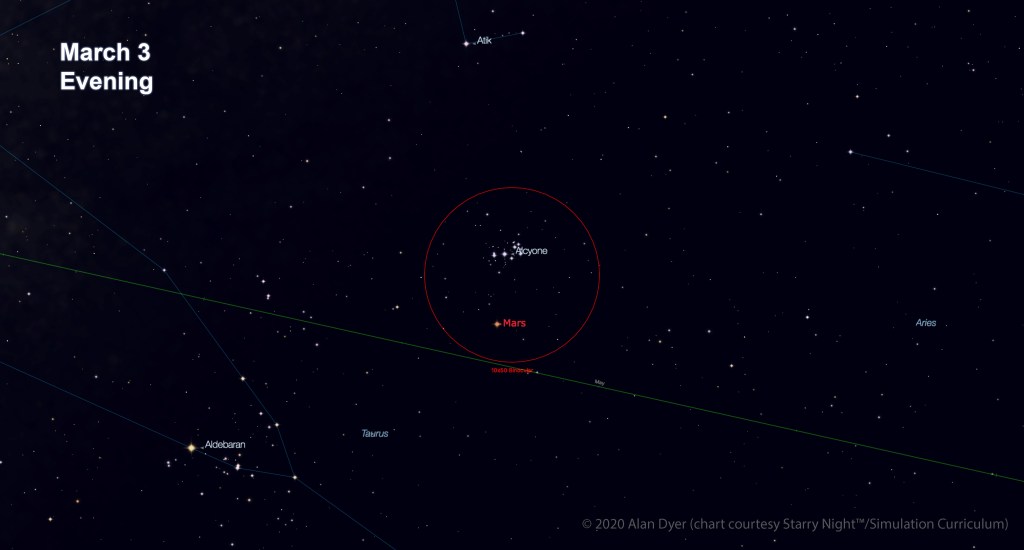
March 3 — Mars 2.5° below the Pleiades
This will be a nice sight in binoculars tonight and tomorrow high in the evening sky, and a good target for tracked telephoto lens shots.
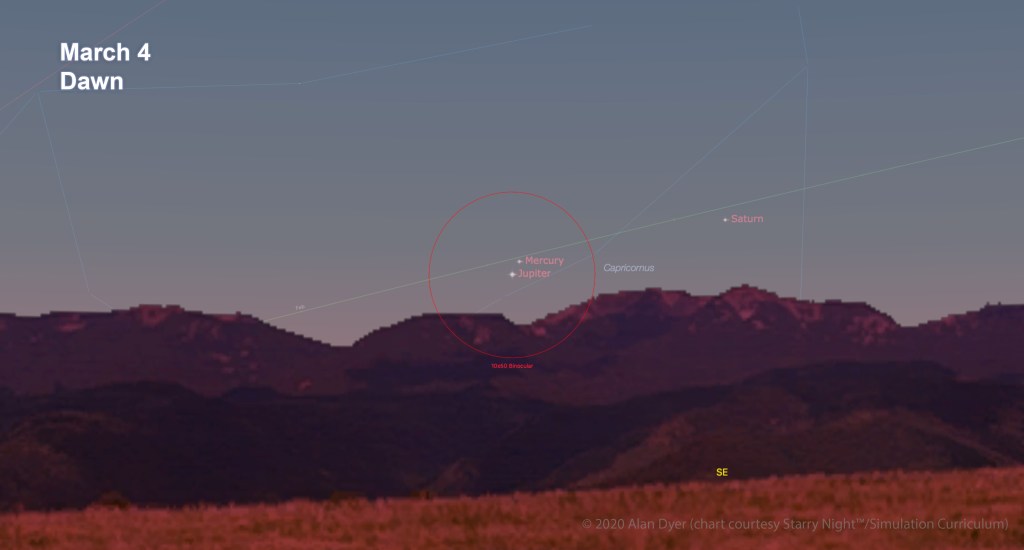
March 4 — Mercury and Jupiter just 1/2° apart
Close to be sure! But this pairing will be so low in the dawn sky it will be difficult to spot. They will appear equally close on March 5 should clouds intervene on March 4.

March 9 — Line of Mercury, Jupiter, Saturn and waning crescent Moon
Three planets and the waxing crescent Moon form a line across the dawn sky but again, very low in the southeast. The even thinner Moon will be below Jupiter on March 10. Observers at low latitudes (south of 35° N) will have the best view on these mornings.
March 20 — Equinox at 5:37 a.m. EDT
Spring officially begins for the northern hemisphere, autumn for the southern, as the Sun crosses the celestial equator heading north. Today, the Sun rises due east and sets due west for photo ops.
March 30 — Zodiacal light season again!
With the Moon out of the way, the faint zodiacal light can again be seen and photographed in the west over the next two weeks, but only from a site without significant light pollution on the western horizon.
April
The inner planets appear in the evening sky, while Mars meets M35.

April 6 — Milky Way arch season begins
With the waning Moon just getting out of view, this morning and for the next two weeks are good nights to shoot panoramas of the bright summer Milky Way as an arch across the sky, with the galactic core in view to the south. The moonless first two weeks of May, June and July will also work this year, but by August the Milky Way is reaching high overhead and so is difficult to capture in a horizontal landscape panorama.
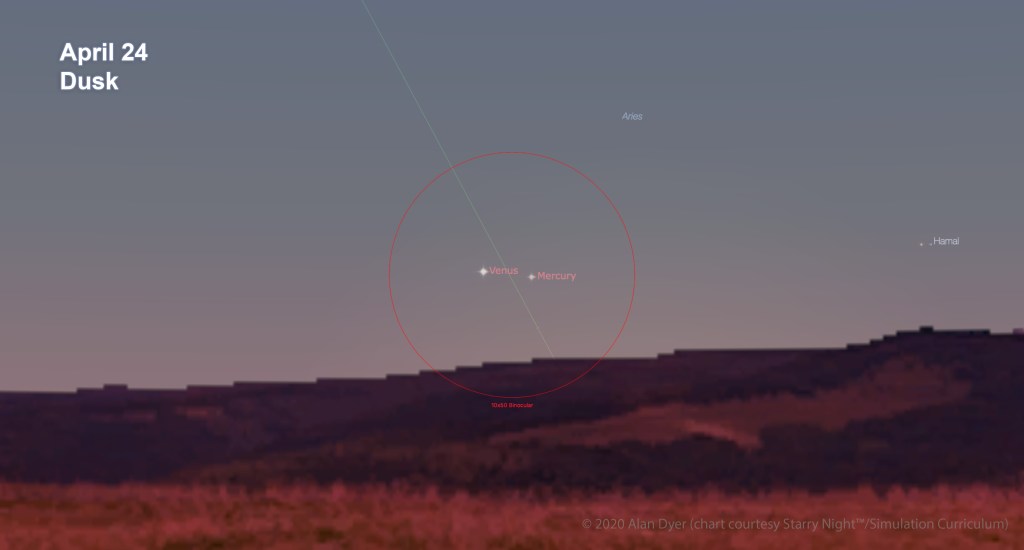
April 24 — Mercury and Venus 1° apart
The two inner planets will be very low in the western evening sky tonight and tomorrow, but with clear skies this is a chance to catch both at once. Use a telephoto lens for the best image.
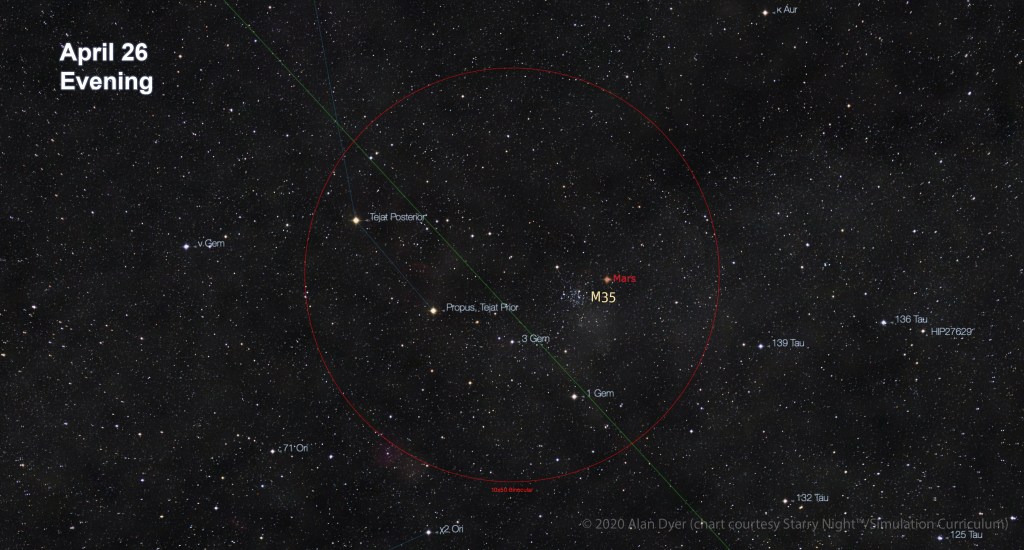
April 26 — Mars passes 1/2° north of M35 star cluster
This will be a fine scene for binoculars or a photo op for a tracked telephoto lens or telescope in a long enough exposure to reveal the rich star cluster Messier 35 in Gemini.
May
On May 26 a totally eclipsed Moon shines red in the west before sunrise for western North America.
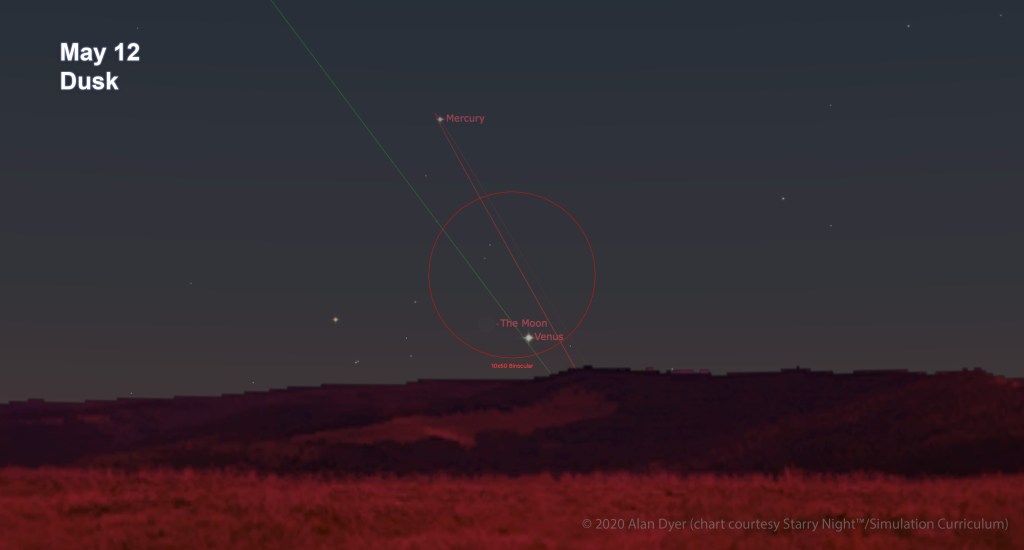
May 12 — Venus and Moon 1.5° apart
Look low in the western evening sky this night for the pairing of the thin crescent Moon and Venus, and the next night, May 13, for the crescent Moon higher and 4° away from Mercury. These are good nights to capture both inner planets using a short telephoto lens.
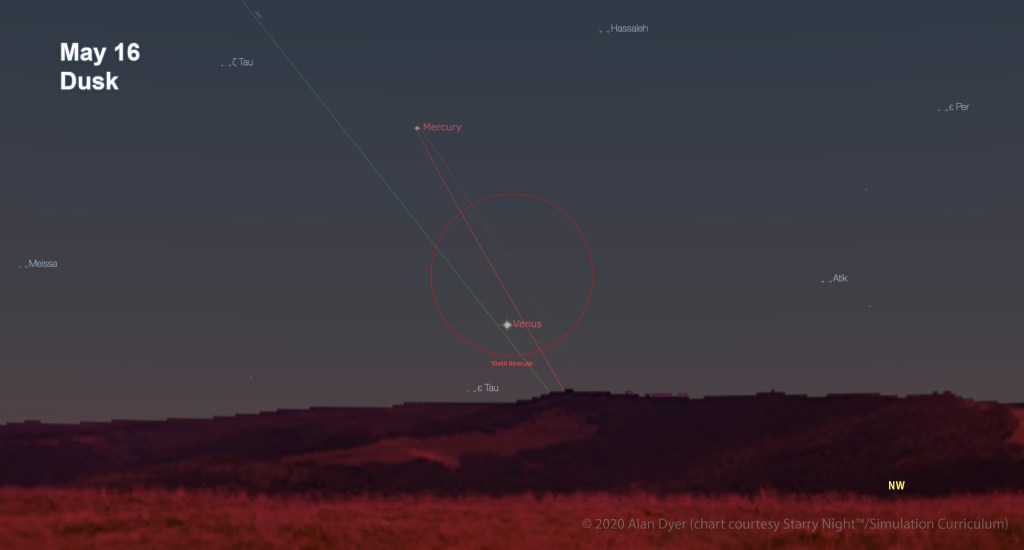
May 16 — Mercury at a favourable evening elongation
With Mercury angled up high in the northwest this is the best week of the year to catch it in the evening sky from northern latitudes.

May 26 — Total Eclipse of the Moon
The first total lunar eclipse since January 20, 2019, this “TLE” can be seen as a total eclipse only from western North America, Hawaii, and from Australia and New Zealand. Totality lasts a brief 15 minutes, with the Moon in Scorpius not far from red Antares. The red Moon in a twilight sky will be beautiful, as it was for the April 4, 2015 eclipse at dawn over Monument Valley, Utah shown above.
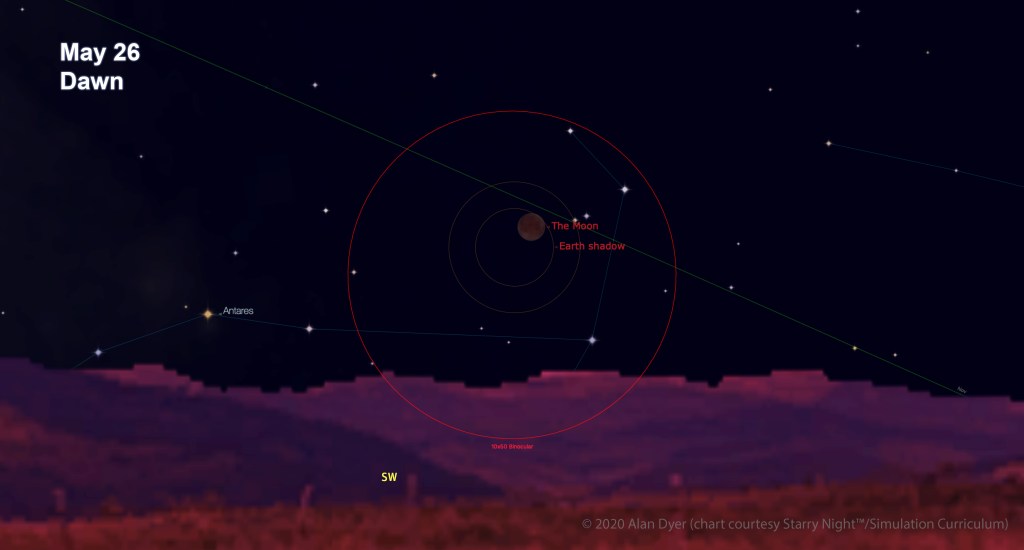
Those in western North America will see the totally eclipsed Moon setting into the southwest in the dawn hour before sunrise, as depicted here. Over a suitable landscape this will be a photogenic scene, as even at mid-eclipse the Moon will be bright red because it passes so far from the centre of Earth’s umbral shadow.
Unfortunately, those in eastern North America will have to be content with a view of a partially eclipsed Moon setting in the morning twilight.
A bonus is that this is also the closest and largest Full Moon of 2021, with a close perigee of 357,311 kilometres occurring just 9 hours earlier. So the Full Moon that rises on the evening of May 25 will be the year’s “supermoon.”

See Fred Espenak’s EclipseWise.com page for details on timing and viewing regions. The dark region on this map does not see any of this eclipse.
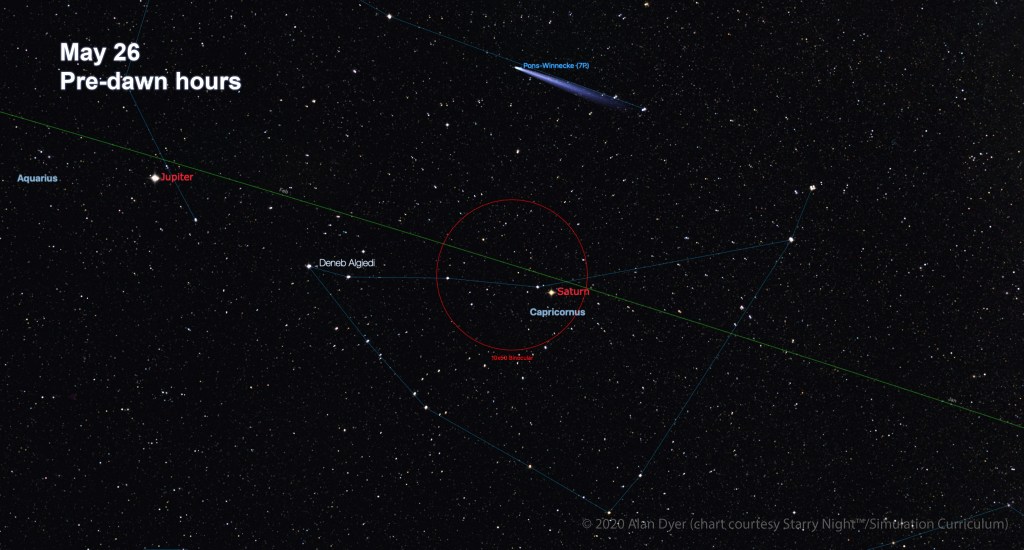
May 26 — Comet 7/P Pons-Winnecke at perihelion
The brightest comet predicted to be visible in 2021 (as of this writing) is the short-period Comet Pons-Winnecke (aka Comet 7/P). It reaches its closest point to the Sun — perihelion — the night of the lunar eclipse and is well placed in Aquarius high in the southeastern dawn sky above Jupiter and Saturn.
But … it is expected to be only 8th magnitude, making it a binocular object at best, looking like a fuzzball, not the spectacular object depicted here in this exaggerated view of its brightness and tail length.
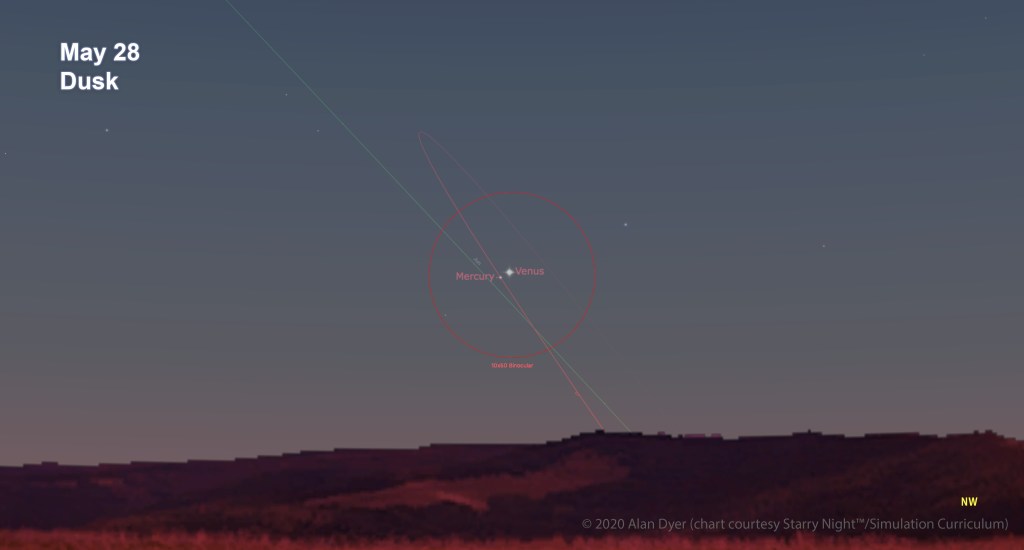
May 28 — Mercury and Venus less than 1/2° apart
Look low in the northwest evening sky for a very close conjunction of the two inner worlds. A telescope will frame them well, with Mercury a tiny crescent and Venus an almost fully illuminated disk.
June
While eastern North America misses the total lunar eclipse, two weeks later observers in the east do get to see a partial solar eclipse.
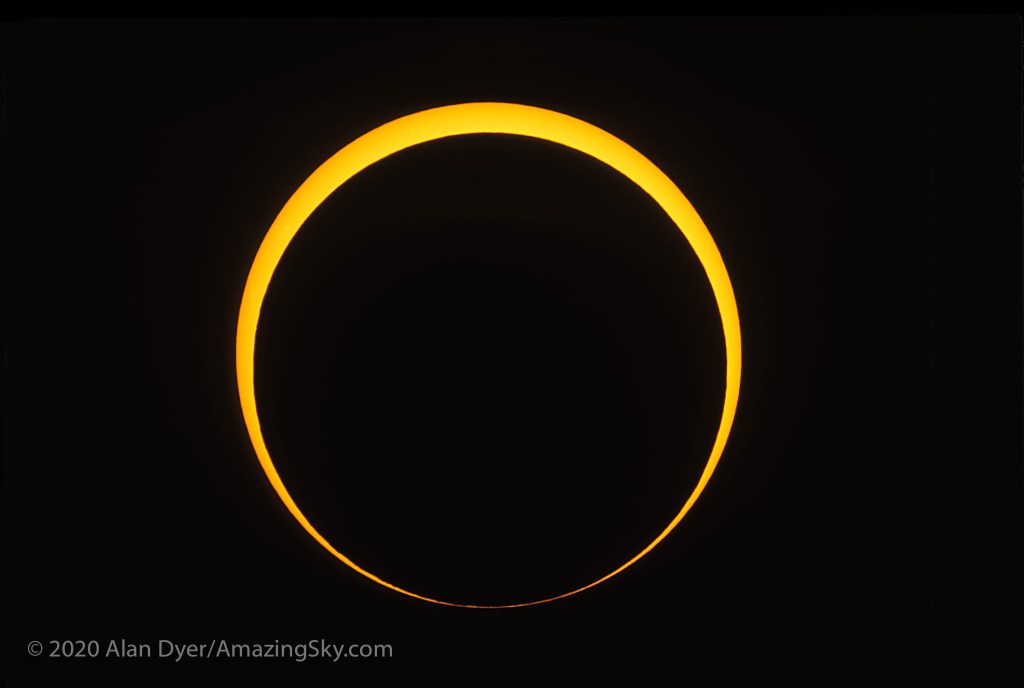
June 10 — Annular eclipse of the Sun
Should you manage to get yourself to the path of the Moon’s anti-umbral shadow you will see the dark disk of the Moon contained within the bright disk of the Sun but not large enough to cover the Sun completely. You see a ring of light, as above from a 1994 annular eclipse.
The Moon is near apogee, so its disk is about as small as it gets, in contrast to the perigee Moon two weeks earlier. During the maximum of 3 minutes 51 seconds of annularity the sky will get unusually dark, but none of the dramatic effects of a total eclipse will appear. The annulus of sunlight that remains is still so bright special solar filters must be used at all times, covering the eyes and lenses.
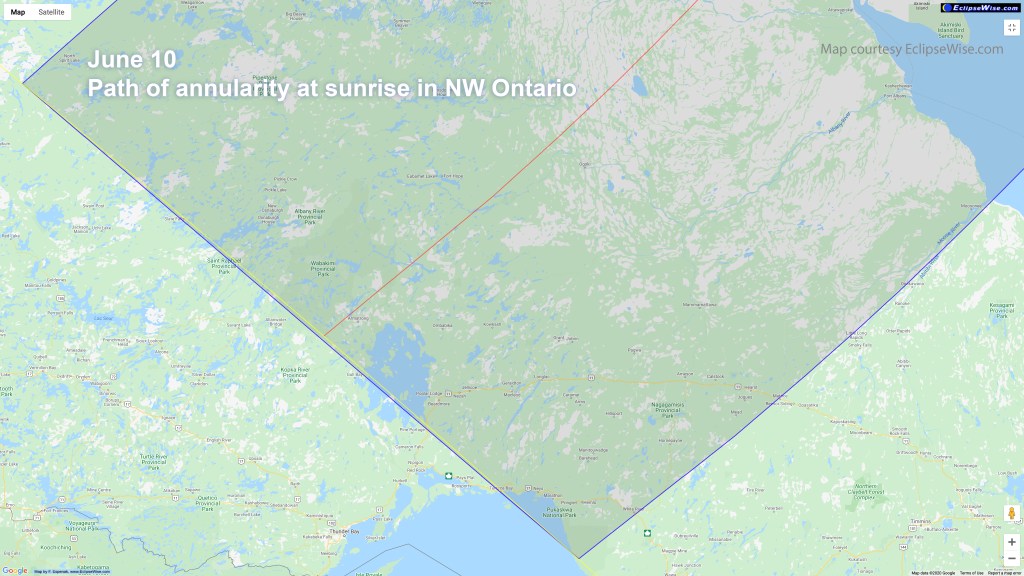
The region with the best accessibility to the path is northwestern Ontario north and east of Thunder Bay. However, the annular phase of the eclipse there occurs at or just after sunrise, so clouds are likely to obscure the view, as are trees!

The eastern seaboard of the U.S. and much of eastern Canada can see a partial eclipse of the Sun, as can most of Europe. For details of times and amount of eclipse see Fred Espenak’s EclipseWise website.
For an interactive Google map of the path see this page.
June 20 — Solstice at 11:32 p.m. EDT
Summer officially begins for the northern hemisphere, winter for the southern, as the Sun reaches its most northerly position above the celestial equator. The Sun rises farthest to the northeast and sets farthest to the northwest, and the length of daylight is at its maximum.
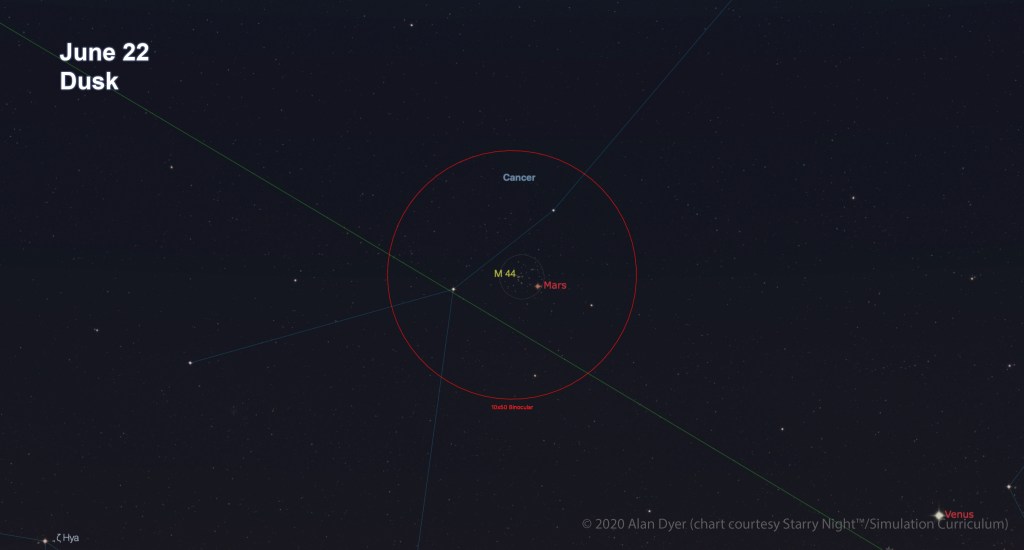
June 22 — Mars passes through the Beehive star cluster
Mars, now at a modest magnitude +1.8, appears amid the Beehive star cluster, aka M44, tonight and tomorrow evening, but low in the northwest in the twilight sky. Use binoculars or a telescope for the best view.
July
Venus and Mars put on a show low in the western twilight.

July 2 — Venus passes through the Beehive star cluster
Venus (at a brilliant magnitude -3.9) follows Mars through the Beehive cluster this evening, but with the pairing even lower in the sky, making it tough to pick out the star cluster.
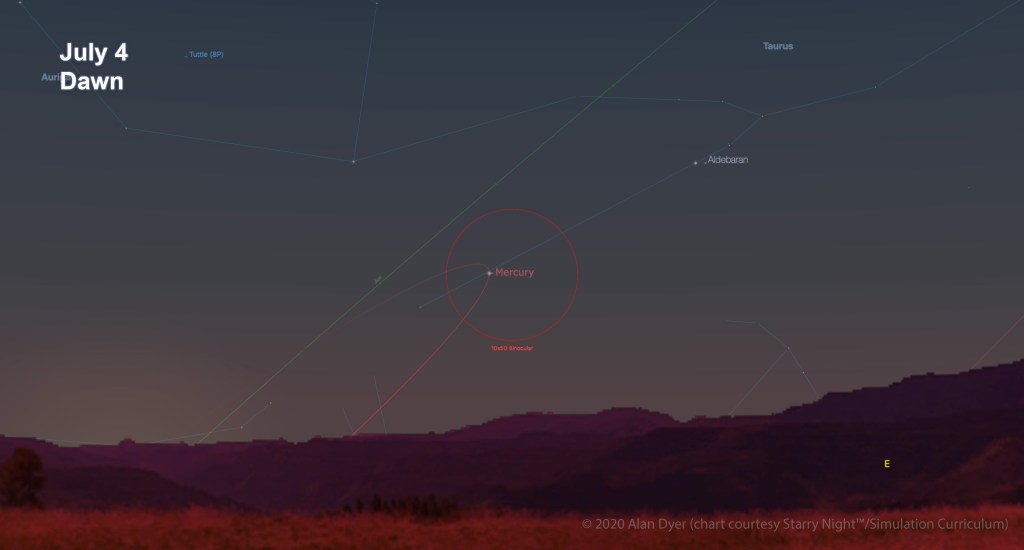
July 4 — Mercury at a good morning elongation
Though not at its best for a morning appearance from northern latitudes, Mercury should still be easy to spot and photograph in the pre-dawn sky in Taurus, outshining bright Aldebaran.

July 11 — Grouping of Venus, Mars and waxing crescent Moon
Look low in the evening sky for the line of the thin crescent Moon, bright Venus and dim Mars all in the same binocular field. Venus passes 1/2° above Mars on the next two nights, July 12 and 13.
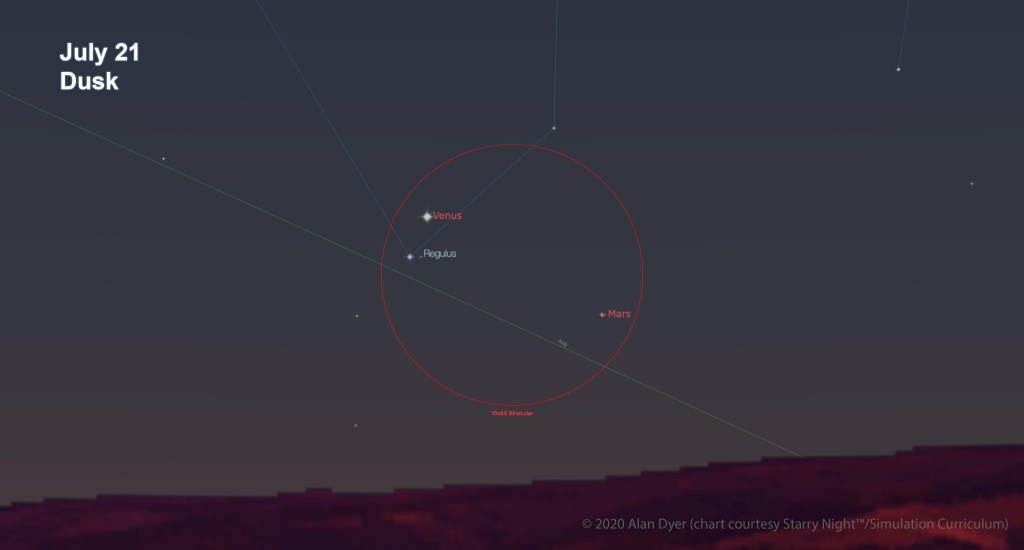
July 21 — Grouping of Venus, Mars and Regulus
The two planets appear with bright Regulus in Leo, all within a binocular field, but again, low in the northwest twilight. The colour contrast of red Mars with white Venus and blue-white Regulus should be apparent in binoculars.
August
The popular Perseid meteors peak, and we can see (maybe!) the extremely close conjunction of Mercury and Mars.
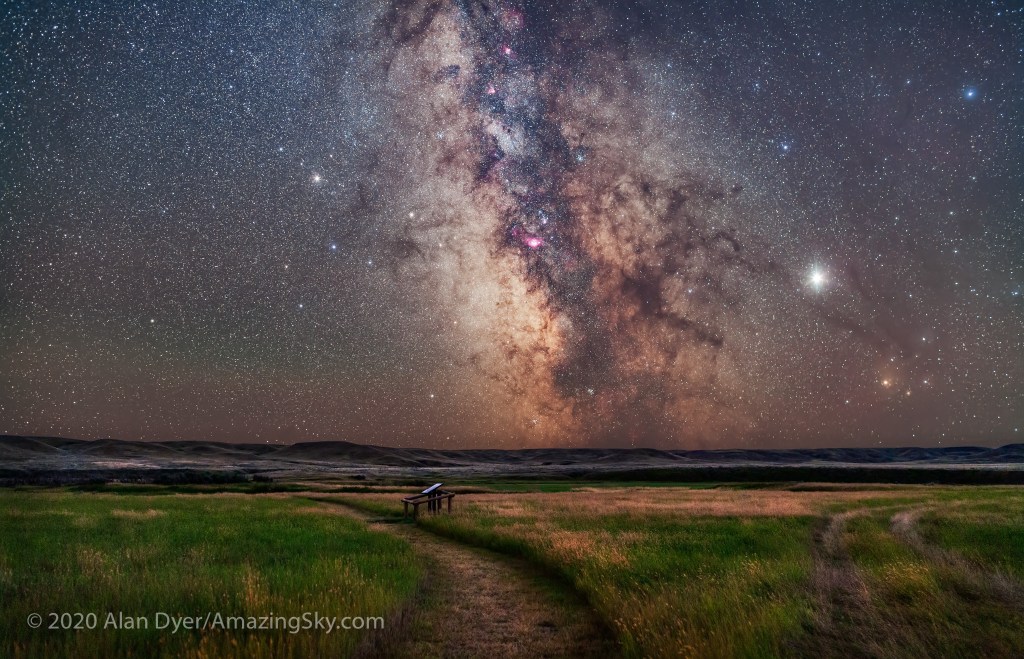
August 1 — Milky Way core season opens
For southerly latitudes, the first two weeks of May and June are also good, but from the northern U.S. and much of Canada, the nights don’t get dark enough to see and shoot the bright galactic centre until August. The rich star clouds of Sagittarius now shine due south as it gets dark each night over the next two weeks.
August 2 — Saturn at opposition
Saturn is at its closest and brightest for 2021 tonight, rising at sunset and shining due south in Capricornus in the middle of the night.

August 12 — Perseid meteor shower peaks
The annual Perseid meteor shower peaks tonight with a waxing crescent Moon that sets early, to leave most of the night dark and ideal for watching meteors. Look for the crescent Moon 5° above Venus on August 10.
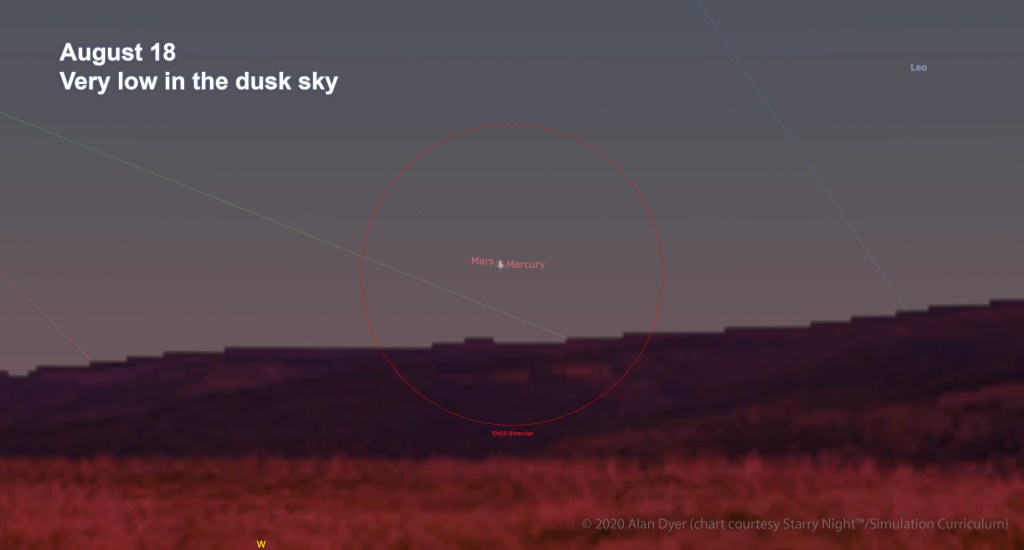
August 18 — Mars and Mercury only 0.06° apart!
Now this is a very close conjunction, with Mercury passing only 4 arc minutes from Mars (compared to the 6 arc minute separation of the Great Conjunction of Jupiter and Saturn on December 21, 2020). But the planets will be very low in the west at dusk and tough to sight. This will be a conjunction for skilled observers blessed with clear skies and a low horizon.
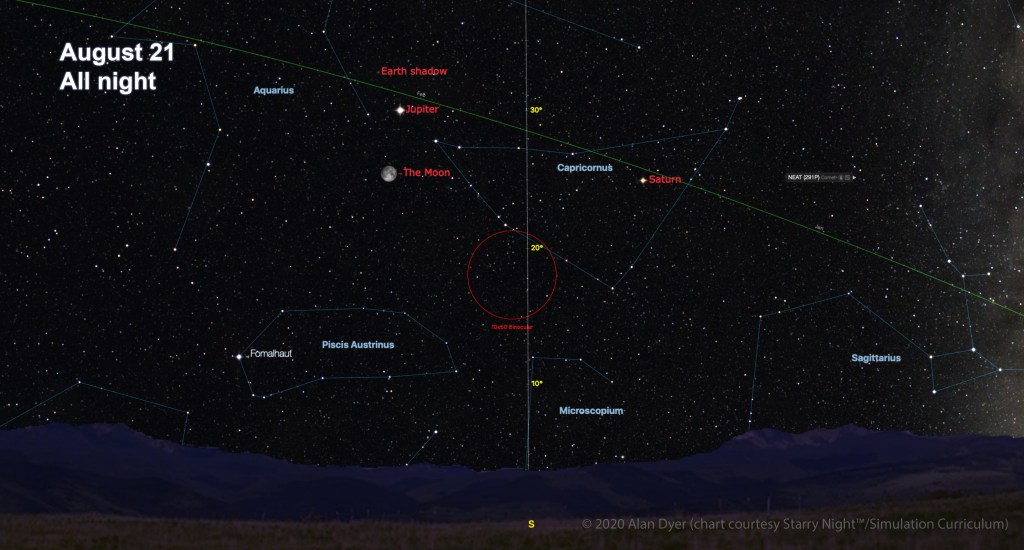
August 20 — Jupiter at opposition
Jupiter, now in Aquarius, reaches its closest and brightest for 2021 tonight, also rising at sunset and shining due south in the middle of the night. On the night of August 21/22, the Full Moon, also at opposition — as all Full Moons are — appears 4° below Jupiter, as shown above.
September
It’s Harvest Moon time, with this annual special Full Moon occurring close to the equinox this year for an ideal geometry, making the Moon rise due east.
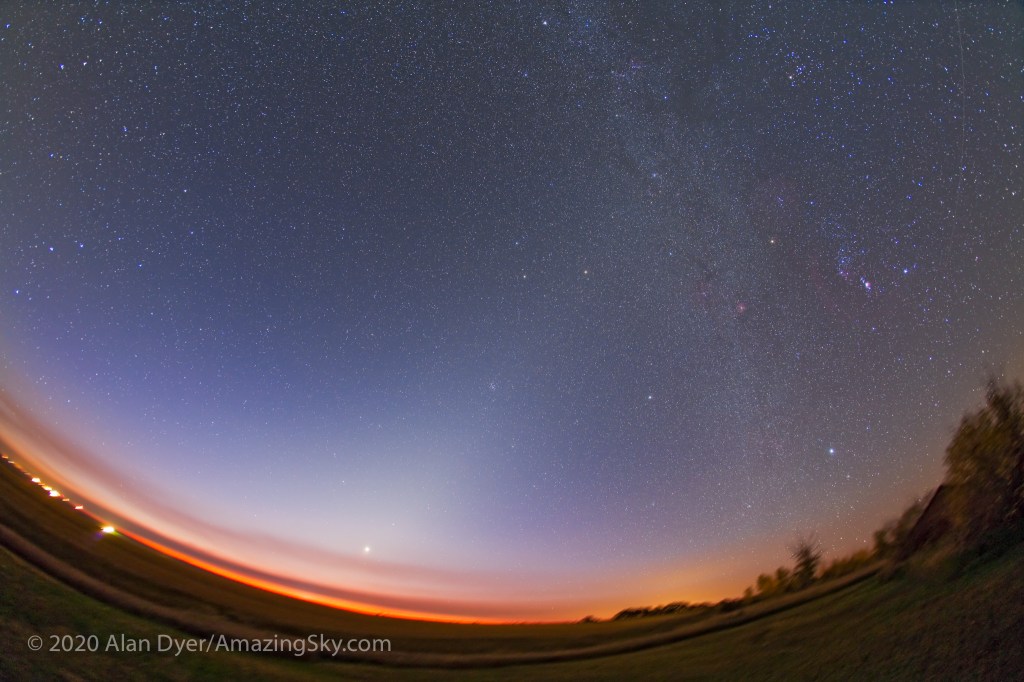
September 5 — Zodiacal light “season” begins in the morning
With no Moon for the next two weeks, from sites away from light pollution look to the pre-dawn sky for a faint glow of light rising out of the east before twilight brightens the morning sky.
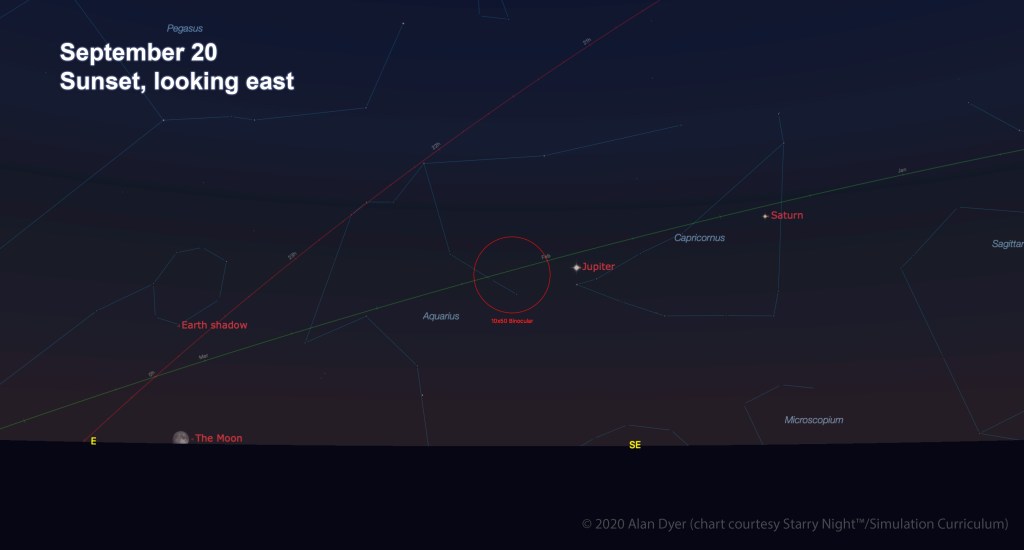
September 20 — Full “Harvest” Moon
Occurring two days before the equinox, this Full Moon will rise nearly due east (a little to the south of east) at sunset and set nearly due west at sunrise at dawn on September 21, for some fine photo ops.
September 22 — Equinox at 3:21 p.m. EDT
Autumn officially begins for the northern hemisphere, spring for the southern, as the Sun crosses the celestial equator heading south. Today, the Sun rises due east and sets due west for photo ops.
October
Mercury adorns the dawn while Venus shines bright but low at dusk.
October 4 — Zodiacal light “season” begins in the morning
With the Moon out of the way for the next two weeks, the zodiacal light will again be visible in the east in the pre-dawn hours.
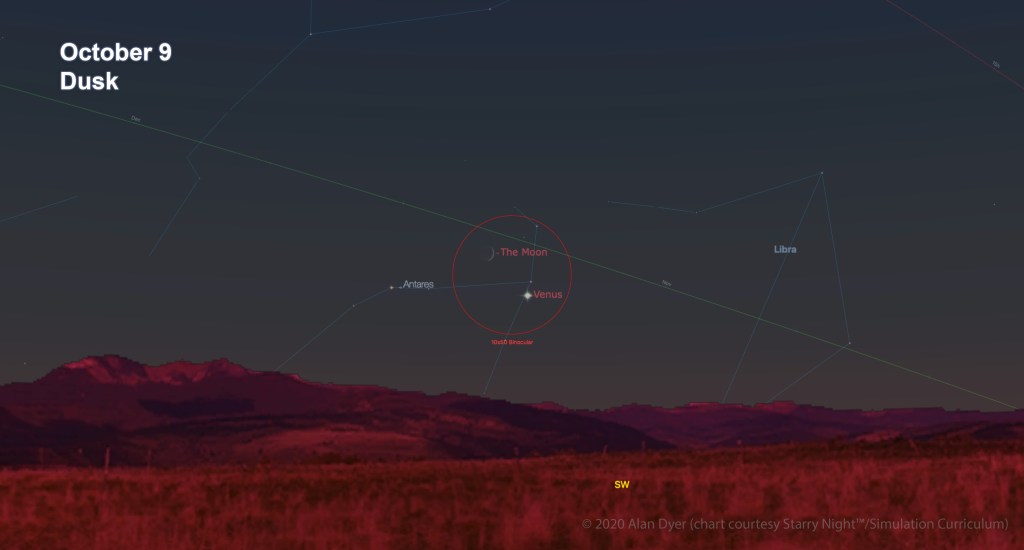
October 9 — The Moon 2.5° from Venus
The crescent Moon passes close to Venus this evening, with the pair not far from the star Antares. The low altitude of the worlds lends itself to some fine photo ops. Look for a similar close conjunction on the evening of November 7.
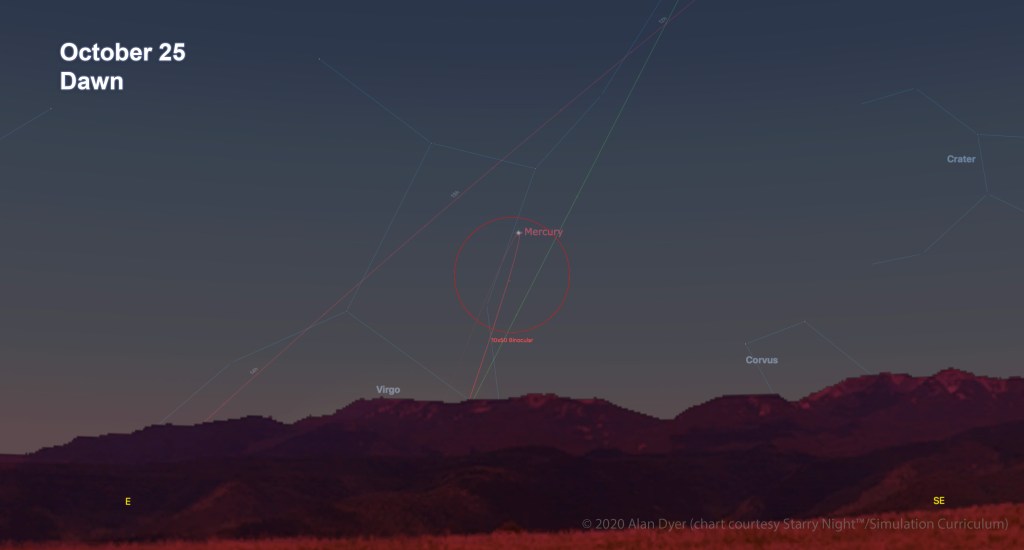
October 25 — Mercury at its most favourable morning elongation
The high angle of the ecliptic — the path of the planets — on autumn dawns swings Mercury up as high as it can get in the morning sky, making this week the best for sighting Mercury as a “morning star” in 2021 from northern latitudes.
October 29 — Venus at its greatest angle away from the Sun
While now farthest from the Sun in our sky, its low altitude at this time of year makes this an unfavourable evening appearance of Venus.
November
The second lunar eclipse brings a mostly red Moon to the skies over North America.

November 3 — Moon and Mercury 2° apart, then a daylight occultation
Before dawn, with Mercury still well-placed in the morning sky, the waning crescent Moon shines 2° above the planet, with Mars below and the star Spica nearby. Later in the day, about noon to early afternoon (the time varies with your location), the Moon will occult (pass in front of) Mercury. This will be a challenging observation even with a telescope, with the pale and thin Moon only 14° east of the Sun. A very clear sky will be essential!

November 19 — 97% Partial Eclipse of the Moon
Though not a total eclipse, this is the next best thing: a 97% partial! And unlike the May 26 eclipse, all of North America gets to see this one.
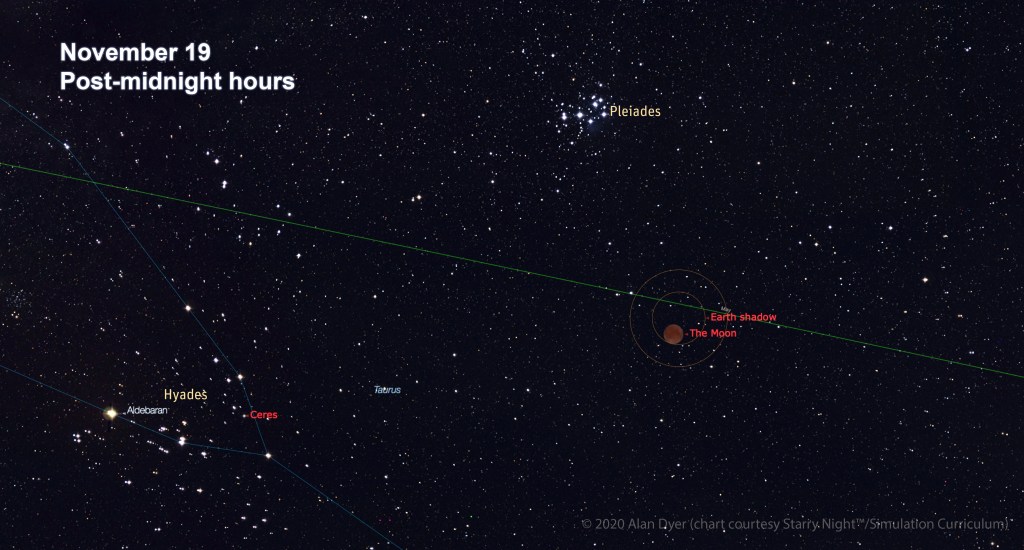
Mid-eclipse, when the Moon is most deeply embedded in Earth’s umbral shadow, occurs at 4:04 a.m. EST (1:04 a.m. PST) on November 19. While not convenient timing, it ensures that all of the continent can see the entire 3.5-hour long eclipse. The partial umbral phase begins at 3:18 a.m EST (12:18 a.m. PST).
At mid-eclipse, the Moon will resemble Mars — a red world with a bright south “polar cap” caused by the small 3% of the southern edge of the Moon outside the umbra. Its position near the Pleiades and Hyades clusters will make for a great wide-field image.
Remember — this occurs on the night of November 18/19! So don’t miss it thinking the eclipse starts on the evening of November 19. You’ll be a day late!

For details see Fred Espenak’s EclipseWise site. As above, the dark region on this map does not see any of this eclipse.
December
The year ends with a chance to see four planets together at dusk.
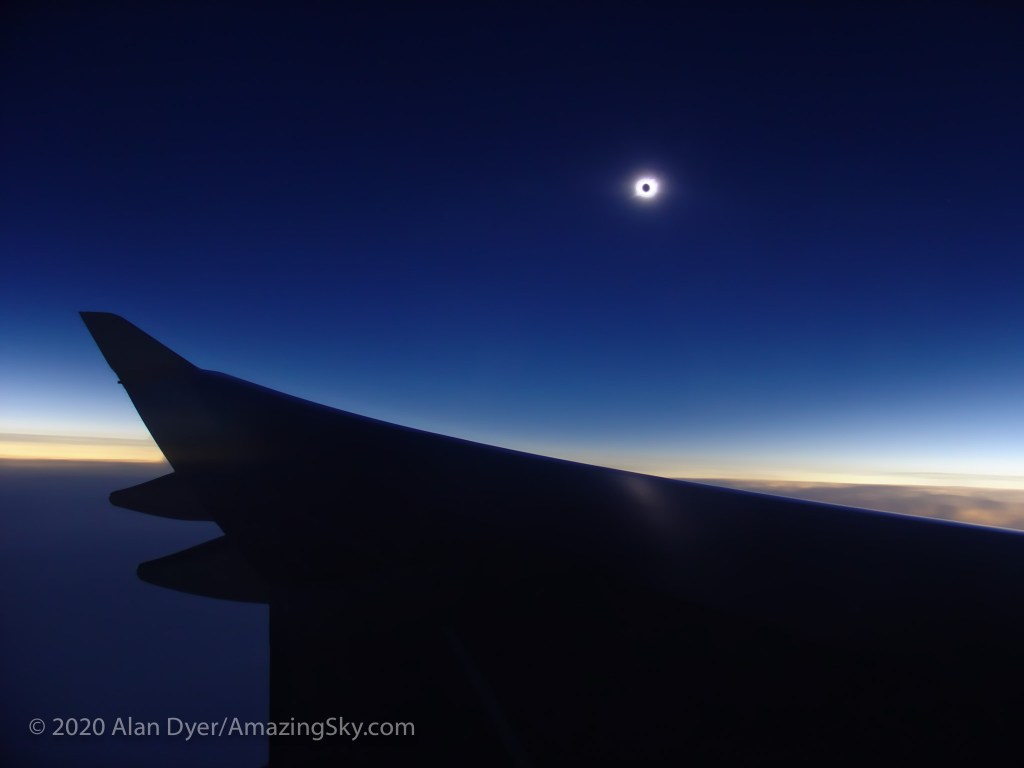
December 4 — Total Eclipse of the Sun
I include this for completeness, but this total solar eclipse (TSE) could not be more remote, as the path of totality lies over Antarctica. Only the most intrepid will be there, in expedition ships and in aircraft. (I took this image over Antarctica at the November 23, 2003 total eclipse one 18-year Saros cycle before this year’s TSE.) Even the partial phases are visible only from southernmost Australia and Africa.
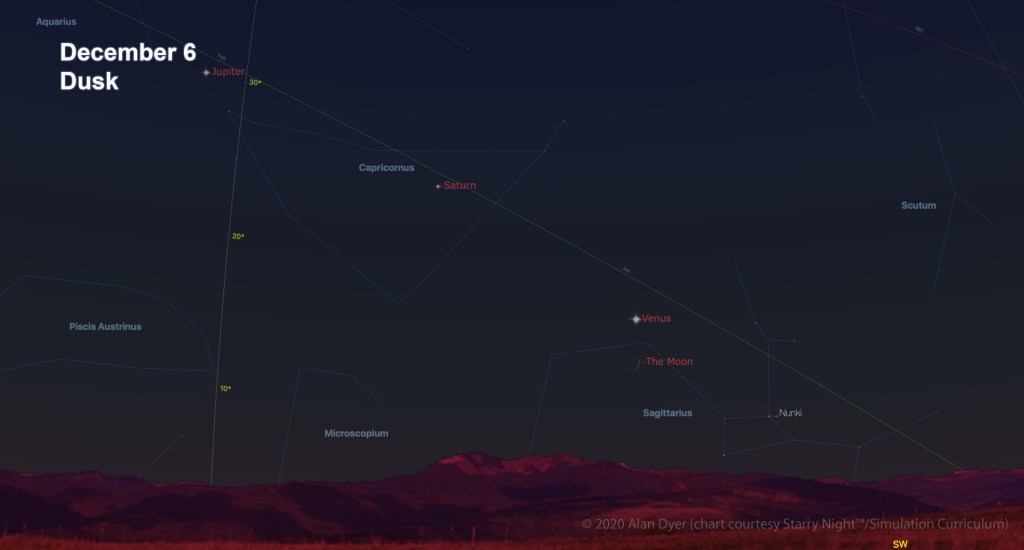
December 6 — Moon 2.5° below Venus
With Venus just past its official December 3 date of “greatest brilliancy” (at magnitude -4.7), the waxing crescent Moon appears close below it, with Saturn and Jupiter further along the line of the ecliptic in the southwest. The Moon appears below Saturn on December 7 and below Jupiter on December 8.

December 13 — Geminid meteor shower peaks
The most prolific meteor shower of the year peaks with a waxing 10-day-old gibbous Moon lighting the sky, so not great conditions. But with luck it will still be possible to see and capture bright fireballs.
December 21 — Solstice at 10:59 a.m. EST
Winter officially begins for the northern hemisphere, summer for the southern, as the Sun reaches its most southerly position below the celestial equator. The Sun rises farthest to the southeast and sets farthest to the southwest, and the length of daylight is at its minimum.
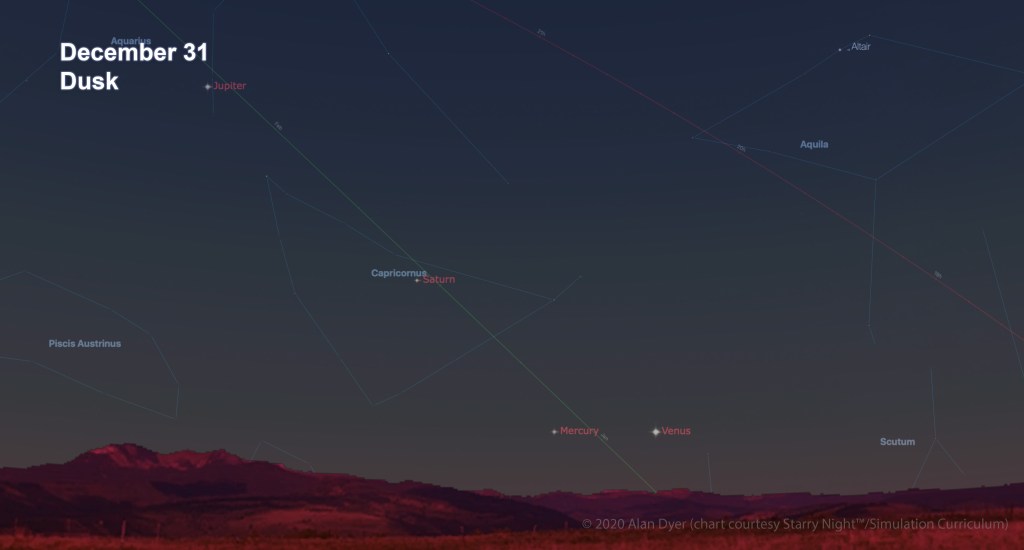
December 31 — Four planets in view
As the year ends the same three planets that adorned the evening sky in early January are back, with the addition of Venus. So on New Year’s Eve we can see four of the naked eye planets (only Mars is missing) at once in the evening sky.
Good luck, good viewing, and clear skies in 2021!
For lots of tips and techniques for shooting the night sky, see my Nightscape and Timelapse ebook linked to above.
— Alan, December 26, 2020 / © 2020 AmazingSky.com


Thanks for information
i love too much astronomy
I miss your calendars but this is a wonderful replacement. Thank you!!